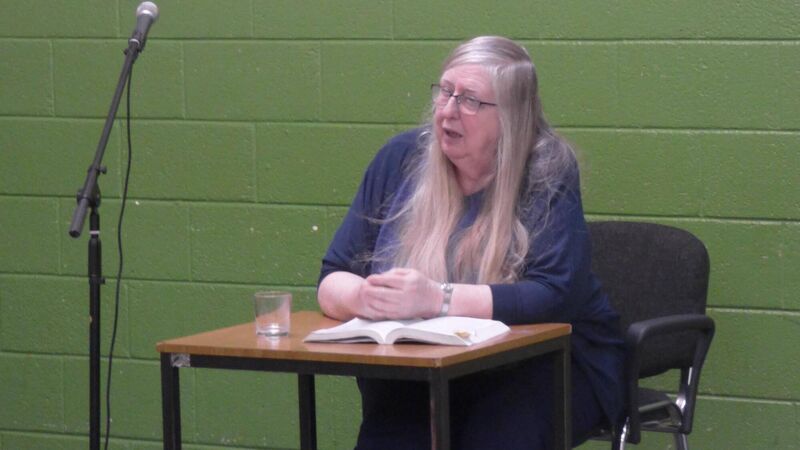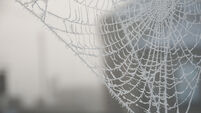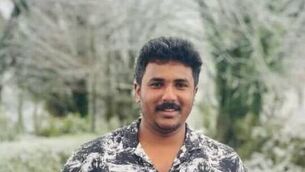Cork childhood inspired Eileán’s ‘mysterious’ poetry

Celebrating Literacy- Eilean Ní Chuilleanain reads from her poetry featured on the Leaving Certificate course during a workshop with senior cycle students in Roscommon Community College.
PRESIDENT Higgins once said of Eileán Ní Chuilleanáin: “Eileán’s poems have, at their heart, an instinctive understanding of the importance of indicating the right of each individual mind to reflect on and see the world in its own way”.
When reminded of this, the Cork-born poet, who recently turned 80, says she has always been interested in the idea of understanding different perspectives.
“All my writing life I have been accused of being rather obscure, and then people who wanted to put it nicely said that I was mysterious, and I think what it is, is that when I want to write about something it is because it’s a mystery to me, and I think maybe I can make this a little bit clearer.
“But I’m very aware that it’s quite idiosyncratic, and I often do find in some people’s poetry maybe an assumption that their ideas are shared to a greater degree than I would actually accept that.”
It has been more than half a century since she has lived in Cork, but she likes to visit when she can, and this weeks she will address a Leaving Cert class in Glanmire Community College.
“My father was born in Cork city, but he came from a railway family, so they moved around. He then, in due course, became a professor of Irish in UCC, and I grew up in what was then the warden’s house of the Honan hostel, which was just beside the college, because my father was the warden.”
She went to UCC herself – “I would never have thought of going anywhere else” - and she went from Cork to Oxford, where she says she was not happy. An advertisement for a job in Trinity College Dublin brought her back to Ireland, and, she says, “that really the story of my life”.
She taught for many years in the School of English in Trinity, where she is emeritus professor, and she was made a Fellow of the college.
“Cork has had a huge effect on my imagination, various things about the city, like the small size of it and its history, also artistic history,” she says.
Her father had six unmarried sisters, and, she recalls, Cork was then very much a town of convents. Her aunts were very traditional – “especially the ones who were not nuns” – she says. “The nuns were quite active and interesting people, but the others lived a very old-fashioned life, which I have difficulty still in understanding.”
Her mother was Eilís Dillon, an author of children’s books, and Eilís’s mother was Geraldine Plunkett, sister of Joseph Mary Plunkett, one of the signatories of the Proclamation of the Irish Republic, who was executed after the 1916 Rising.
“My mother came from a very strong Republican tradition, but also very interested in culture. She played the cello in the Cork Symphony Orchestra when Aloys Fleischmann was running it, so there was a strong musical side to Cork at that time, which I was very much interested in.
“That cultural side of Cork was very, very active, I think because of the size of the city at that time, because it was so small that everybody went to everything.
“Since I’ve lived in Dublin, I tend to find that there’s a theatre audience and there’s people who go to exhibitions, and there’s people who go to concerts, and they’re not all the same people but in Cork, they were all the same people, and that led, I think, to quite an intense cultural life.”
She believes that Cork affected her choice to become a writer of poetry.
“On the one hand, because my mother was a prose writer, I think we were into diversification in our family. I took to poetry, my younger sister, who died 30 years ago, she became a professional violinist.

“On the other hand, also, one of the reasons that I took to poetry was a feeling that Cork at that time was very much a place of realist writing. The two major figures, of course, were Frank O’Connor and Seán Ó Faoláin, neither of whom was living in Cork, but they both gave a certain colour to the place.”
She mentions Daniel Corkery, mentor to both O’Connor and Ó Faoláin, and that reminds her of Corkery’s headstone, sculpted by Seamus Murphy, her parents’ great friend, in the same graveyard in Turner’s Cross where her father is buried.
“Like Seán Ó Riada, like various luminaries of the time, your career was, as it were, topped off by getting Seamus to do your headstone.”
She says Seamus Murphy was succeeded by Ken Thompson, who sculpted Ní Chuilleanáin’s mother’s gravestone, and in turn, Ken Thompson was succeeded by his son, Matt Thompson, who lives towards Ballycotton. “This is a real apostolic succession, shall we say.”
Says Matt Thompson sculpted the gravestone of her husband Macdara Woods, who passed away four years ago.
As most of us did, she found the Covid-19 pandemic a strange, surreal time.
“I was actually working on my collected poems, putting the final touches to that, during the pandemic, and it seemed as if I was looking back over my writing career, from a sort of cloud, a non-place and a non-time, because everything was so different.”
Her 2009 poem about the Cork polio epidemic of 1956 was regularly quoted during Covid, and it featured in the TG4 documentary Eipidéim. “When Covid started, I found that I’d already written the poem about epidemics. I was a child, I was 13, when the polio epidemic happened, but a lot of things were the same.
“The staying at home, the going out into empty places, or places where, especially as a child that you didn’t meet another child during the polio epidemic, and a certain amount of fear, of course.”
A member of Aosdana for many years, she was last year elected Saoi, which translates as “sage”, becoming the 21st Saoi in the history of the assembly.
The honour is bestowed for singular and sustained distinction in the arts and, in November, President Higgins presented her with the symbol of the office, a gold Torc.
“One of the things that being a Saoi means is that you’re very old,” she says, laughing.
“It’s people like Beckett and Edna O’Brien, most of them are pretty old. Beckett is dead, of course, which doesn’t help.”
Of the seven Saoi, she describes and Edna O’Brien and herself as “the only two literature people”
“It was a very nice gesture. They nominated me and I had to get half of the membership plus one, so I got at least that many people who consented to it. I was really touched by the honour.”
As we finish our telephone conversation, she says she has every intention of holding onto the gold Torc for as long as she can.
“Nobody has said this to me, but it’s tactfully conveyed by the list of people who’ve had it before me, that it goes back to them when I die. I shall have to leave a note for my son,” she says with an audible smile.







 App?
App?


